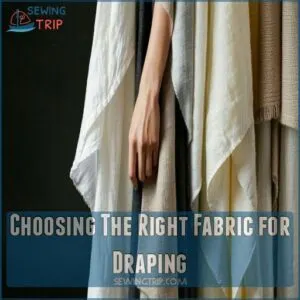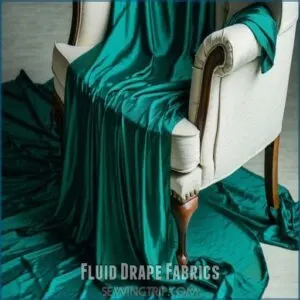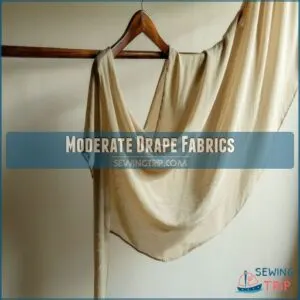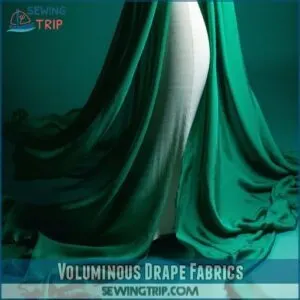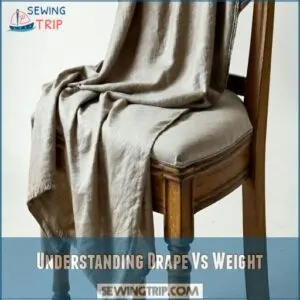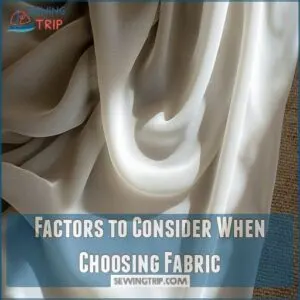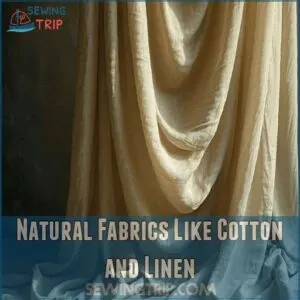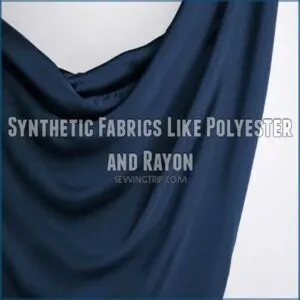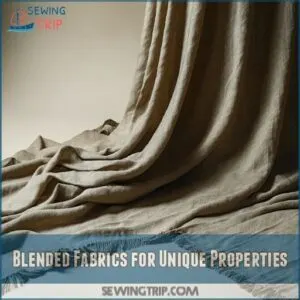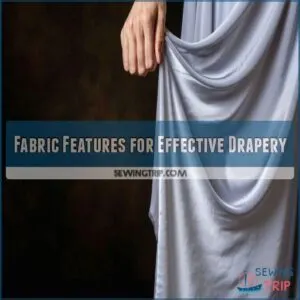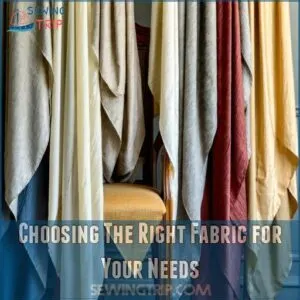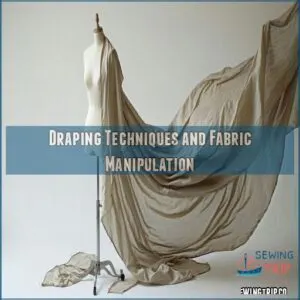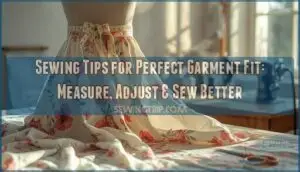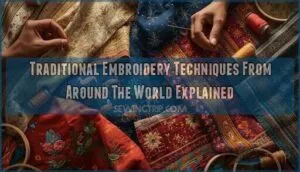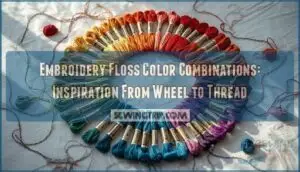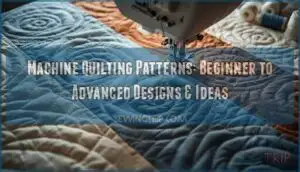This site is supported by our readers. We may earn a commission, at no cost to you, if you purchase through links.
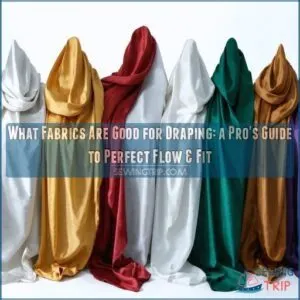 You’ll find that lightweight, flowing fabrics are perfect for draping.
You’ll find that lightweight, flowing fabrics are perfect for draping.
Natural options like silk charmeuse, chiffon, and lightweight cotton voile create elegant cascades and graceful folds.
For more structure with maintain fluid movement, try rayon challis or silk crepe.
Medium-weight fabrics including jersey, velvet, and wool crepe offer balanced drape while holding their shape.
The key is choosing materials with enough flexibility to create soft curves without being too limp or stiff.
Your fabric’s weight and weave structure determine how it’ll move and fall – master these elements, and you’ll discover the secrets to achieving those Pinterest-worthy draped designs you’ve been dreaming of.
Table Of Contents
- Key Takeaways
- Choosing The Right Fabric for Draping
- Best Fabrics for Draping by Drape Type
- Understanding Drape Vs Weight
- Factors to Consider When Choosing Fabric
- Popular Fabrics for Draping
- Fabric Features for Effective Drapery
- Choosing The Right Fabric for Your Needs
- Draping Techniques and Fabric Manipulation
- Common Mistakes to Avoid When Choosing Fabric
- Frequently Asked Questions (FAQs)
- Conclusion
Key Takeaways
- You’ll get the best draping with lightweight, flowing fabrics like silk charmeuse, chiffon, and cotton voile, which naturally create elegant cascades and graceful folds.
- Your fabric’s weight doesn’t always determine drape quality – even lightweight materials can hang stiffly while some heavier fabrics flow beautifully.
- You should test your fabric’s draping potential by holding it at shoulder height to observe how it cascades and checking its recovery after pinching.
- You’ll want to choose fabrics based on your specific needs – fluid fabrics like silk for flowing evening wear, moderate drape fabrics like jersey for everyday garments, and voluminous fabrics like taffeta for structured pieces.
Choosing The Right Fabric for Draping
You’ll find that selecting the right fabric for draping combines art and science, as each material’s weight and flow can dramatically affect your final design.
Fabric choice will determine how well your creation skims the body and creates the perfect silhouette.
Whether you’re working with fluid silks or structured polyesters, your fabric choice will determine how well your creation skims the body and creates the perfect silhouette.
Assessing Fabric Weight and Drape
Want to nail that perfect drape? Start by understanding how fabric weight and drape work together. While heavier fabrics like denim tend to hold their shape, lighter materials like chiffon flow effortlessly. You can also find a wide range of fabrics suitable for draping at drape fabric weight stores.
Here’s what you’ll need to check:
- Test the fabric’s natural fall by holding it up and letting it hang
- Observe how it moves when you walk with it
- Check if it clings or stands away from the body
- Compare its weight against similar fabrics you’ve worked with
Evaluating Texture, Sheen, and Hand Feel
When selecting fabric for draping, your fingertips are your best tools.
Run your hands over the material – you’re looking for surfaces that feel smooth and consistent.
Fabrics with a subtle sheen often create elegant drapes, while matte finishes offer a more understated look.
Notice how the fabric moves between your fingers; a supple, fluid texture typically indicates good draping potential.
Considering Fabric Suitability for Draping
Before diving into your draping project, you’ll need to assess your fabric’s suitability carefully.
Test how it moves and falls by holding a sample at shoulder height – does it cascade gracefully or stand stiffly?
Pay attention to its recovery too; pinch and release the fabric to see if it bounces back or stays creased.
The way fabric behaves during these simple tests reveals its true draping potential.
Budget and Desired Aesthetic
Looking up from your budget spreadsheet to your mood board, you’ll need to strike that perfect balance between cost and style.
Smart fabric choices let you achieve luxurious drape without breaking the bank.
- Mix high-end fabrics in focal points with budget-friendly options in less noticeable areas
- Consider sustainable fabrics like bamboo rayon that offer elegant drape at moderate prices
- Watch for seasonal sales on premium materials like silk charmeuse and crepe de chine
Best Fabrics for Draping by Drape Type
You’ll find that different fabrics create distinct draping effects, from fluid silks that gracefully follow your body’s curves to structured materials that hold dramatic shapes.
Draping effects are a key consideration for any garment, whether you’re working on an elegant evening gown or a flowing summer dress.
Understanding how each fabric type drapes will help you achieve the exact look you’re after.
Fluid Drape Fabrics
Fluid drape fabrics gracefully flow and embrace every curve, creating ethereal silhouettes that dance with your movement.
Here’s a quick guide to fabrics that’ll give you that perfect, liquid-like drape:
| Fabric Type | Weight | Best Uses |
|---|---|---|
| Silk Charmeuse | Lightweight | Evening gowns |
| Crepe de Chine | Medium-light | Draped dresses |
| Rayon Challis | Light-medium | Flowy skirts |
These fabrics move like water, making them perfect for designs that need to cascade naturally against the body.
Moderate Drape Fabrics
When you need fabrics that strike the sweet spot between clinging and stiff, moderate drape fabrics are your go-to choice.
These versatile materials offer a balanced flow that works beautifully for everyday wear.
Here are the most popular options:
- Cotton jersey with medium weight
- Light wool crepe
- Silk charmeuse
- Viscose blends
- Medium-weight rayon
These fabrics create garments that skim your body’s natural curves without clinging too tightly, offering both comfort and style.
Voluminous Drape Fabrics
Picture a dramatic ballgown that commands attention – that’s the magic of voluminous drape fabrics.
Stiff materials like taffeta, organza, and heavyweight silk create bold, structured silhouettes that stand away from the body.
These fabrics excel at architectural designs and dramatic statements, perfect for special occasions.
You’ll find them holding their shape beautifully in wedding gowns, evening wear, and avant-garde fashion pieces.
Understanding Drape Vs Weight
You’ll find that a fabric’s weight doesn’t always determine its draping quality, as even lightweight materials can hang stiffly while some heavier fabrics flow beautifully.
Drape and weight are important considerations when selecting fabric.
Before selecting your fabric, you’ll need to think about both its weight and drape characteristics to achieve the perfect look for your project.
Correlation Between Fabric Weight and Drape
The relationship between fabric weight and drape plays like a dance – they often move together, but not always in perfect harmony.
Heavier fabrics typically create structured, dramatic silhouettes, while lighter materials tend to flow more freely against the body.
A fabric’s drape coefficient, which can be determined through a drape coefficient test, also affects how it hangs and moves.
- Heavy brocade (24 oz/yd²) falls with architectural precision
- Medium-weight crepe (12 oz/yd²) offers balanced movement
- Light chiffon (4 oz/yd²) creates fluid, ethereal effects
Understanding this partnership helps you orchestrate the perfect drape for your designs.
Exceptions to The Rule
Your fabric’s drape may defy expectations, as heavy materials don’t always yield poor drape. Case in point: tweed jackets gracefully skim the body, while slinky silk refuses to cling.
Appearances can be deceiving – thoroughly examining a fabric’s weight, texture, and movement is key to predicting its drape.
| Fabric | Weight | Drape |
|---|---|---|
| Tweed | Heavy | Fluid |
| Silk Chiffon | Light | Poor |
| Cotton Sateen | Moderate | Moderate |
| Linen | Lightweight | Voluminous |
Importance of Considering Both Weight and Drape
Whether a fabric is lightweight or heavy, both weight and drape influence its suitability for your project.
Consider the following:
- Lightweight fabrics don’t always drape well due to their lack of body.
- Heavy fabrics may hang stiffly, failing to achieve the desired fluid movement.
- The perfect fabric strikes the right balance, complementing your design vision.
Factors to Consider When Choosing Fabric
When draping, you’ll want to keep in mind the fabric’s weight, texture, and drape.
Different fabrics like chiffon, satin, and crepe de chine each offer unique properties that can dramatically impact the final look and feel of your garment.
Color and Pattern Selection
In terms of fabric draping, color and pattern selection play a pivotal role.
Embrace trending hues that spark joy, and let patterns elevate your design.
From bold graphics to subtle motifs, find the right scale to complement your vision.
Color psychology can also guide your choices, setting the mood and enhancing the overall look.
Texture and Weight Considerations
Fabric texture and weight work hand in hand to create your desired drape effect.
Heavy fabrics tend to have poor drape due to their stiffness, while lighter textiles often offer more fluid movement.
Experiment with a range of weights and textures to find the perfect balance for your project’s style and silhouette.
Opacity and Light Control
The opacity of your fabric plays a pivotal role in light control and privacy.
Sheer fabrics allow for soft, breezy draping while filtering in natural light.
Room-darkening options provide maximum privacy and block out sunlight.
Consider fabric liners to customize the level of opacity and light filtration for your space.
Striking the right balance is key for an inviting, functional look.
Durability and Maintenance Needs
Of course, fabric durability and maintenance demands can’t be overlooked.
After all, your gorgeous drapes ought to stand the test of time.
Consider fabrics with enhanced stain and wrinkle resistance for high-traffic areas.
For delicate sheers, seek out gentle dry-cleaning methods.
Ultimately, prioritize easy-care options that keep your space looking its best.
| Fabric Type | Durability | Maintenance |
|---|---|---|
| Cotton | High | Machine wash, iron if needed |
| Polyester | Moderate | Machine wash, tumble dry |
| Silk | Low | Dry clean only |
| Linen | High | Dry clean or hand wash |
Popular Fabrics for Draping
Choosing the right fabric is key for achieving the perfect drape.
From natural fibers like cotton and linen to synthetics like polyester and rayon,
there’s a wide range of fabrics perfect for your next draping project.
Natural Fabrics Like Cotton and Linen
Natural cotton and linen make excellent options for draping.
Cotton offers everyday versatility, holding its shape while softening over time.
Linen, with its unique texture and crisp, lightweight feel, drapes beautifully for a relaxed, flowing look.
Both fabrics age gracefully and pair well with sustainable production methods – a win for style and the planet.
Synthetic Fabrics Like Polyester and Rayon
If you’re looking for budget-friendly draping options, synthetic fabrics like polyester and rayon are worth considering.
Polyester boasts impressive durability, wrinkle resistance, and versatility, making it a practical choice.
Rayon, on the other hand, offers a silky, fluid drape that mimics the look and feel of natural fibers.
These synthetic wonders can help you achieve your drapery dreams without breaking the bank.
- Polyester: Durable, wrinkle-resistant, and cost-effective
- Rayon: Smooth, fluid drape with a natural fiber feel
- Easy care: Machine washable and quick-drying
- Wide range of colors and patterns available
Blended Fabrics for Unique Properties
Blended fabrics offer unparalleled versatility, combining the best properties of different materials.
From durable polyester-cotton mixes to sustainable bamboo-viscose blends, these innovative textiles deliver a winning combination of drape, performance, and eco-friendliness.
Experiment with unique fiber blends to create the perfect fabric for your draping projects.
| Fabric Blend | Drape Quality | Durability | Sustainability |
|---|---|---|---|
| Polyester-Cotton | Moderate | High | Moderate |
| Bamboo-Viscose | Fluid | Moderate | High |
| Linen-Silk | Voluminous | Moderate | High |
| Wool-Cashmere | Fluid | High | Moderate |
Fabric Features for Effective Drapery
Fabrics with certain features are ideal for achieving flawless drape. Understanding fabric durability, light control, insulation, and maintenance can guarantee your drapes hang beautifully and last for years.
Durability and Longevity
For durable, long-lasting drapery, blended fabrics are your best bet.
By combining natural fibers like cotton or linen with synthetic materials, you get the best of both worlds – timeless style and exceptional durability.
These versatile blends hold up beautifully over time, ensuring your drapes stay fresh and vibrant for years to come.
Light Control and Light Filtration
Sheer fabrics provide privacy with light penetration, allowing airy spaces to feel open and bright.
Linen sheers, such as linen sheer curtains, are particularly effective at balancing light control and visibility while resisting sun damage and color fading.
Blackout options, on the other hand, completely block out light – perfect for bedrooms or home theaters that need total darkness.
Consider the room’s function and your privacy needs when selecting the right fabric for light control and drape.
Insulation Against Heat and Cold
Beyond their visual appeal, fabrics used in drapery offer valuable insulation against both heat and cold.
Thicker textiles create an extra barrier, trapping air and regulating indoor temperatures.
Layering techniques further enhance this effect.
Look for fabrics with inherent thermal properties, or consider lining draperies for maximum energy efficiency and comfort.
Maintenance and Care Instructions
Regular fabric maintenance is key for drapery that stays looking its best.
While sheer fabrics may require a gentler touch, all drapery should be vacuumed regularly using the upholstery attachment.
For deeper cleaning, consider using specialized fabric drapery cleaning products to get the job done.
Professional dry cleaning is also recommended.
Proper storage and occasional ironing or steaming can also extend the life of your draperies.
| Fabric Type | Cleaning Approach | Special Considerations |
|---|---|---|
| Sheer | Gentle hand-wash or dry clean | Avoid over-agitation |
| Cotton/Linen | Machine wash, line dry | Iron while damp to reduce wrinkles |
| Polyester | Machine wash, tumble dry | Check for care label instructions |
| Velvet | Professional dry clean only | Avoid direct sunlight |
| Brocade | Professional dry clean only | Minimize folds and creases |
Choosing The Right Fabric for Your Needs
Choosing the right fabric is key for achieving perfect drape and flow.
Consider the garment style, desired aesthetic, and your budget.
To select the ideal fabric that will bring your vision to life.
Considering The Intended Garment Style
When selecting the right fabric for your desired garment, first consider the style and silhouette.
Flowy dresses call for fabrics with excellent drape, like chiffon or satin, while structured garments benefit from stiffer materials like linen or tweed.
Match the fabric to the intended look – let the cloth inspire the design.
Evaluating The Occasion and Desired Look
Different occasions demand distinct fabric choices for your garment’s perfect drape and overall impact.
Your fabric selection shapes how confidently you’ll move through formal galas or casual gatherings.
For instance, if you’re looking for a fabric that adds a touch of elegance to any formal ensemble, consider using sheer structured fabrics like organza for a fairytale-like effect.
- The fluid elegance of silk charmeuse commands attention at black-tie events
- Light chiffon’s dreamy flow elevates garden party attire
- Structured crepe’s sophisticated drape suits power meetings
- Cotton jersey’s relaxed drape creates effortless weekend style
Consider the event’s formality and desired impression – your fabric choice becomes your silent style statement.
Assessing Budget and Quality Requirements
Savvy fabric selection doesn’t mean emptying your wallet.
Start by setting a realistic budget that aligns with your project’s scope.
You’ll find excellent draping options at various price points – from budget-friendly polyester to mid-range cotton blends and premium silks.
Consider durability and maintenance costs too.
Quality fabric might cost more upfront but can save money long-term through better wear and fewer replacements.
Draping Techniques and Fabric Manipulation
You’ll discover how to transform fabric into stunning designs by mastering essential draping techniques on a dress form.
Working with pins and fabric, you’ll learn to create organic shapes that flow naturally with the body’s contours.
Positioning and Pinning Fabric on a Dress Form
Starting with a well-fitted dress form sets you up for draping success – think of it as your canvas for creating wearable art.
You’ll need a collection of pins, marking tools, and your chosen fabric ready to go.
Here’s your game plan for perfect positioning:
- Start from the center front, working outward systematically
- Pin at key points – shoulders, bust, waist
- Keep fabric grain lines straight and aligned
- Maintain even tension while smoothing fabric
Achieving Desired Drape and Shape
To achieve your desired drape and shape, master the art of fabric manipulation through strategic pinning and gentle shaping.
Create graceful folds by carefully gathering the material at key points, then secure with pins at a 45-degree angle.
For the perfect fabric, consider shopping for drape fabrics online.
Pay attention to how gravity affects the fabric’s fall, and don’t be afraid to adjust pin placement until you’ve captured the perfect silhouette you’re after.
Experimenting With Fabric Movement and Flow
Once you’ve mastered basic pinning, let your creativity soar by playing with fabric movement.
Try gathering sections at different points, creating asymmetrical folds, or experimenting with bias draping for unique effects.
Watch how different fabrics behave when twisted, pleated, or draped at various angles.
This hands-on exploration helps you understand each material’s natural tendencies and discover unexpected design possibilities.
Common Mistakes to Avoid When Choosing Fabric
You’ll save time and money when you understand the common pitfalls in fabric selection for draping projects.
Draping projects can involve creating flowing evening gowns or structured daywear.
Knowing what not to do is just as important as knowing the right techniques.
Ignoring Fabric Weight and Drape
After mastering fabric manipulation, you’ll want to dodge the biggest pitfall: ignoring weight and drape relationships.
Have you ever picked a fabric that looked perfect on the bolt, only to find it hanging like a limp dishrag or standing stiff as cardboard?
You’re not alone. Many sewists learn the hard way that fabric weight doesn’t always predict drape – light fabrics can be surprisingly rigid, while heavier ones might flow beautifully.
Overlooking Texture and Sheen
Beyond weight and drape, texture and sheen can make or break your fabric’s visual impact.
You might fall for a fabric’s drape but miss how its matte finish clashes with your design vision.
Similarly, a glossy sheen that looks stunning on the bolt could create unwanted highlights in your final piece.
Consider how different lighting affects your fabric’s surface – what sparkles in the store might overwhelm in natural light.
Failing to Consider Durability and Maintenance Needs
While texture and sheen catch the eye, ignoring durability and maintenance can lead to costly mistakes.
That stunning silk might require frequent dry cleaning, and wrinkle-prone fabrics can lose their drape faster than expected.
To minimize wrinkles and extend fabric lifespan, think about fabric care tips for sewing that include proper storage, ironing, and drying methods.
You’ll want to think about fabric longevity, stain resistance, and care requirements before making your choice.
Remember: a fabric’s lifespan depends on both its inherent properties and how well you maintain it.
Frequently Asked Questions (FAQs)
What is the best fabric for draping?
Like water flowing over rocks, lightweight fabrics such as silk, chiffon, and crepe de chine create the most elegant drape.
You’ll find these materials naturally cling and flow around the body beautifully.
What material is used for draping?
For draping, you’ll find stretchy knits, chiffon, georgette, and lightweight silks work beautifully.
Organza creates dramatic volume, while tulle offers versatility.
Natural fabrics like cotton and linen provide timeless appeal with excellent draping qualities.
Do heavier fabrics drape better?
No, heavier fabrics don’t automatically drape better.
Surprisingly, lightweight fabrics like silk and chiffon often create the most elegant draping effects.
Weight and drape quality aren’t always connected – it’s about the fabric’s construction.
What fabric holds its shape best?
Structured fabrics like denim, canvas, and heavy cotton twill will hold their shape best.
Interfacing-backed fabrics, sturdy wool, and thick polyester maintain their form exceptionally well during wear.
How much fabric is needed for basic draping?
You’ll need 3-4 yards of fabric for basic draping exercises.
Starting with extra material gives you flexibility to experiment with different techniques and account for mistakes while learning.
Consider doubling that for full garments.
Can draping fabric be reused for different designs?
Like a chameleon changing colors, your draping fabric can transform endlessly.
Whether you’re crafting gowns or experimenting with new designs, properly handled fabric stays versatile and ready for your next creative adventure.
What temperature settings work best for steaming draped fabrics?
Set your steamer between 180-200°F for delicate fabrics and up to 212°F for heavier materials.
Remember to test a small area first, and don’t let the steamer head directly touch your draped fabric.
Does fabric grain direction affect the final drape?
As straight as an arrow, fabric grain impacts drape dramatically.
Cutting on the bias (45-degree angle) will achieve maximum fluidity.
Straight grain creates structure, and cross-grain offers moderate flexibility in your designs.
Which interfacings maintain drape while adding structure?
Lightweight fusible interfacings, especially silk organza and tricot, provide structure while maintaining your fabric’s natural movement.
You’ll find that featherweight weft insertion and knit interfacings also work beautifully for structured, flowing garments.
Conclusion
Like a knight choosing the perfect armor, selecting fabrics good for draping requires careful consideration of weight, texture, and movement.
You’ll find success with lightweight silks and chiffons for fluid cascades, while medium-weight materials like jersey and wool crepe offer balanced structure.
Remember that what fabrics are good for draping depends on your project’s needs. Trust your instincts, experiment with different materials, and you’ll master the art of creating those stunning draped designs you’ve been dreaming about.

